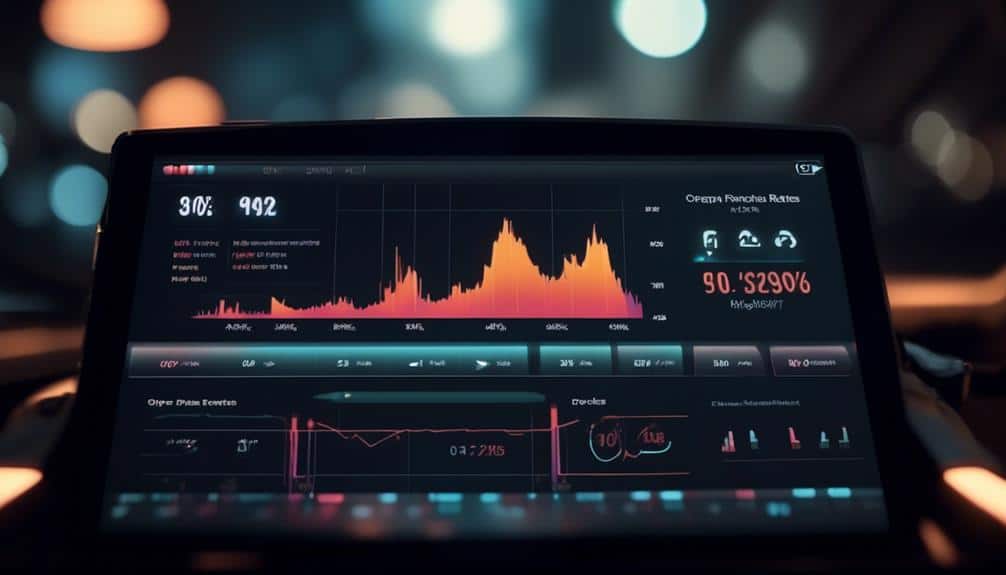Don't Miss: Key Features Your Email Marketing Tool Must Have
Are you looking for an email marketing tool that can take your campaigns to the next level? Look no further.
In today's competitive digital landscape, it's crucial to have the right features at your fingertips to effectively engage your audience and drive results. From an easy-to-use interface to advanced segmentation capabilities, automated email workflows, and A/B testing functionality, the key features your email marketing tool must have are endless.
But that's not all. Stay tuned as we delve into the world of analytics and reporting tools, personalization options, responsive email templates, deliverability monitoring and optimization, and GDPR compliance features.
Get ready to revolutionize your email marketing game with these must-have features.
Key Takeaways
- User-friendly interface and design: An email marketing tool should have an intuitive interface and user-friendly design, making it easy for users to create and send campaigns without requiring coding or design skills. Drag-and-drop functionality and pre-designed templates are essential features that enhance the user experience.
- Advanced segmentation and personalization: Effective targeting of the audience based on demographics, interests, and behavior is crucial for higher engagement and conversions. Advanced segmentation capabilities allow for personalized content, improved relevance, increased deliverability, and automation efficiency, helping to engage and convert the target audience effectively.
- Automated email workflows: Streamlining the process of engaging with the audience through automated email workflows can significantly improve customer experience and save time. Delivering timely and relevant content based on triggers enhances engagement and conversions. It is important to continuously optimize campaigns for better results.
- A/B testing and analytics: A/B testing enables the optimization of email campaigns by experimenting with different elements such as subject lines, content, and call-to-action buttons. Following best practices and utilizing powerful analytics and reporting tools for performance tracking and data-driven decision making are essential for measuring success accurately.
Easy-To-Use Interface

Using an intuitive and user-friendly interface, our email marketing tool makes it effortless for you to create and send impactful campaigns. With our focus on user interface design and user experience optimization, we've created a tool that's both powerful and easy to use.
We understand that your time is valuable, and that's why we've designed our interface to be intuitive and user-friendly, so you can quickly navigate and accomplish your marketing goals.
Our email marketing tool provides a streamlined experience, allowing you to effortlessly create visually stunning campaigns that captivate your audience. With drag-and-drop functionality and pre-designed templates, you can easily customize your emails to reflect your brand and message. No coding or design skills are required, making it accessible to users of all levels.
In addition to an easy-to-use interface, our tool also offers robust features to optimize your user experience. From advanced segmentation options to A/B testing capabilities, you have the tools to personalize your campaigns and maximize engagement. Our intuitive analytics dashboard provides real-time insights, allowing you to track the success of your campaigns and make data-driven decisions.
With our email marketing tool's user interface design and user experience optimization, you can create and send impactful campaigns effortlessly. Focus on serving your audience and let our tool handle the technical aspects, so you can achieve your marketing goals efficiently.
Advanced Segmentation Capabilities
With advanced segmentation capabilities, you can effectively target your audience based on specific criteria such as demographics, interests, and behavior.
This allows you to send personalized email campaigns that resonate with each segment, increasing engagement and conversions.
Targeted Audience Segmentation
To effectively reach and engage your target audience, harness the power of advanced segmentation capabilities. By utilizing targeted audience segmentation, you can tailor your email marketing campaigns to the specific needs and preferences of each segment, resulting in higher customer engagement and conversion rates.
Here are four key benefits of advanced segmentation:
- Personalized Content: Deliver custom-tailored messages that resonate with each segment, making your audience feel understood and valued.
- Improved Relevance: Segmenting your audience allows you to send emails at the right time, with the right content, increasing the chances of conversion.
- Increased Deliverability: By sending relevant emails to specific segments, you reduce the risk of being marked as spam and improve your email deliverability rates.
- Automation Efficiency: Automate your email campaigns based on specific triggers and behaviors, saving time and ensuring timely communication with your audience.
Personalized Email Campaigns
Harness the power of advanced segmentation capabilities to create personalized email campaigns that effectively engage and convert your target audience.
By utilizing email automation tools, you can easily segment your audience based on their preferences, behavior, and demographics. This allows you to send tailored content that resonates with each individual, increasing the chances of conversion.
Personalized email subject lines play a crucial role in capturing the attention of your recipients and encouraging them to open your emails.
With advanced segmentation capabilities, you can go beyond basic personalization and deliver highly targeted messages that address the specific needs and interests of your audience. This level of personalization not only enhances the customer experience but also improves the effectiveness of your email marketing efforts.
Don't miss out on the opportunity to leverage these advanced segmentation capabilities and take your email campaigns to the next level.
Automated Email Workflows

Automated email workflows offer a streamlined and efficient way to engage with your audience and drive conversions. By utilizing automated email triggers, you can deliver timely and relevant content to your subscribers, increasing the chances of them taking action.
Here are four key benefits of incorporating automated email workflows into your email campaign optimization strategy:
- Improved customer experience: Automated workflows allow you to send personalized emails based on specific triggers, such as a subscriber's behavior or interaction with your website. This personalized approach makes your audience feel valued and understood, leading to a better overall customer experience.
- Time-saving automation: With automated email workflows, you can set up and schedule emails in advance, saving you time and effort. Once the triggers are set, the emails will be sent automatically, allowing you to focus on other important tasks.
- Increased engagement and conversions: By sending targeted emails at the right time, you can effectively nurture leads and guide them through the customer journey. This personalized approach increases engagement and encourages conversions, ultimately boosting your ROI.
- Data-driven optimization: Automated email workflows provide valuable data and insights into your subscribers' behavior and preferences. With this information, you can continuously optimize your email campaigns for better results.
Incorporating automated email workflows into your email marketing strategy can significantly enhance your overall campaign performance, providing a seamless and personalized experience for your audience. Don't miss out on the benefits these workflows can bring to your business.
A/B Testing Functionality
When it comes to optimizing your email campaigns, one key feature that can significantly impact your results is the A/B testing functionality.
A/B testing allows you to experiment with different elements of your emails, such as subject lines, content, and call-to-action buttons, to determine what resonates best with your audience. By testing variations of these elements, you can identify the most effective strategies for engaging your subscribers and driving conversions.
To make the most of A/B testing, it's important to follow best practices. Start by testing one element at a time to accurately measure its impact. Set clear goals for your tests and define what success looks like. Ensure you have a large enough sample size to draw statistically significant conclusions. And don't forget to track and analyze your results to gain insights that can inform future campaigns.
To further understand the power of A/B testing, let's look at some case studies. Company X saw a 30% increase in open rates by testing different subject lines. Company Y improved their click-through rates by 20% through testing different call-to-action buttons. And Company Z boosted their conversions by 15% by experimenting with the length of their email content.
Incorporating A/B testing functionality into your email marketing tool can help you refine your strategies and achieve better results. Take advantage of this feature to optimize your campaigns and serve your audience more effectively.
Analytics and Reporting Tools

Get ready to take your email marketing to the next level with the powerful analytics and reporting tools available.
These tools will provide you with performance tracking metrics and real-time campaign data, giving you valuable insights into the success of your email campaigns.
With this data at your fingertips, you can make data-driven decisions to optimize your email marketing strategy and drive better results.
Performance Tracking Metrics
To effectively monitor the success of your email marketing campaigns, utilize the powerful analytics and reporting tools available for tracking performance metrics. These tools provide valuable insights into the effectiveness of your campaigns, allowing you to make data-driven decisions for campaign optimization.
Here are four key performance tracking metrics you should pay attention to:
- Open Rate: Measure the percentage of recipients who open your emails. A high open rate indicates that your subject lines and sender names are compelling.
- Click-through Rate (CTR): Track the percentage of recipients who click on links within your emails. A high CTR indicates that your content and call-to-actions are engaging.
- Conversion Rate: Measure the percentage of recipients who complete a desired action, such as making a purchase or filling out a form. This metric helps you evaluate the effectiveness of your email in driving conversions.
- Unsubscribe Rate: Keep an eye on the percentage of subscribers who unsubscribe from your emails. A high unsubscribe rate could indicate that your content isn't resonating with your audience.
Real-Time Campaign Data
Utilize powerful analytics and reporting tools to gain real-time insights into the performance of your email marketing campaigns. With real-time campaign tracking, you can monitor the effectiveness of your email campaigns as they happen, allowing you to make immediate adjustments and optimizations.
These tools provide you with valuable data, such as open rates, click-through rates, and conversion rates, enabling you to measure the success of your email marketing efforts. By having access to real-time campaign data, you can identify trends, understand customer behavior, and make data-driven decisions to improve your email marketing strategy.
Additionally, email marketing automation can further enhance your campaign data analysis by providing detailed reports and metrics, allowing you to evaluate the performance of your automated email sequences and make necessary adjustments for optimal results.
Take advantage of these analytics and reporting tools to maximize the impact of your email marketing campaigns.
Integration With CRM Software
Integrating your email marketing tool with CRM software streamlines your customer data management and enhances marketing effectiveness. Here are four reasons why CRM integration is crucial for your email marketing success:
- Seamless Data Synchronization: By integrating your email marketing tool with CRM software, you can ensure that customer data is automatically synced between the two platforms. This eliminates the need for manual data entry and ensures that your email campaigns are always based on the most up-to-date customer information.
- Personalized Campaigns: With CRM integration, you can leverage the rich customer data in your CRM system to create highly personalized email campaigns. By segmenting your audience based on their preferences, purchase history, and behavior, you can deliver targeted messages that resonate with each individual recipient.
- Automated Workflows: CRM integration enables you to automate various email marketing tasks, such as sending welcome emails, abandoned cart reminders, or birthday greetings. By setting up automated workflows, you can save time and effort while ensuring that your customers receive timely and relevant messages.
- Enhanced Reporting and Analytics: Integrating your email marketing tool with CRM software provides you with comprehensive reporting and analytics capabilities. You can track the performance of your email campaigns, measure conversion rates, and gain valuable insights into your customers' behavior. This data allows you to optimize your email marketing strategies and improve your overall marketing effectiveness.
Personalization Options

When it comes to email marketing, personalization is key to engage your audience. With customized email content, you can tailor your messages to each individual subscriber, increasing the chances of them taking action.
Dynamic personalization tags allow you to insert personalized information such as the recipient's name or location, making the email feel more personalized and relevant.
Additionally, behavioral segmentation enables you to send targeted emails based on your subscribers' past actions, ensuring that they receive content that aligns with their interests and preferences.
Customized Email Content
Customized email content enhances engagement and drives conversion rates by delivering personalized messages tailored specifically to each recipient. To achieve this, your email marketing tool must have the following features:
- Custom Email Design: Create visually appealing emails that align with your brand and capture your audience's attention.
- Targeted Messaging: Segment your email list based on demographics, preferences, and behaviors to send relevant content to each group.
- Dynamic Content: Use dynamic fields to insert personalized information into your emails, such as the recipient's name or recent purchases.
- Behavioral Triggers: Set up automated emails triggered by specific actions, such as abandoned carts or completed purchases, to provide timely and relevant messages.
Dynamic Personalization Tags
To enhance the personalization of your emails, dynamic personalization tags provide a powerful tool for delivering tailored content to each recipient. Dynamic content optimization allows you to create personalized messages by inserting specific tags that automatically populate with individual subscriber information. This technique enables you to address each recipient by name, mention their previous purchases or preferences, and even include personalized recommendations based on their browsing history.
By using dynamic personalization tags, you can make your emails feel more personal and relevant, increasing engagement and conversion rates. This level of personalization shows your subscribers that you understand their needs and interests, building trust and loyalty.
Incorporating these email personalization techniques will help you stand out in crowded inboxes and deliver a more personalized experience to your subscribers.
Behavioral Segmentation
Behavioral segmentation offers a powerful way to personalize your email marketing campaigns. By analyzing your subscribers' behavior and preferences, you can create targeted and relevant content that increases customer engagement and drives conversion optimization.
Here are four key benefits of using behavioral segmentation in your email marketing:
- Increased open rates: By sending emails based on subscribers' past interactions, you can deliver content that's more likely to catch their attention, resulting in higher open rates.
- Improved click-through rates: By tailoring your email content to match subscribers' interests and preferences, you can increase the likelihood of them clicking on your links and taking action.
- Enhanced customer satisfaction: By sending relevant and personalized emails, you show your subscribers that you understand their needs and value their preferences, leading to increased satisfaction and loyalty.
- Higher conversion rates: By delivering targeted offers and recommendations based on subscribers' behavior, you can improve the chances of converting them into paying customers.
Incorporating behavioral segmentation into your email marketing strategy can greatly improve your results and help you build stronger relationships with your subscribers.
Responsive Email Templates

Responsive email templates are designed to adapt and display correctly across various devices and screen sizes. With the increasing number of people accessing their emails on mobile devices, it's crucial to ensure that your emails are optimized for mobile viewing. By implementing responsive design techniques, your email marketing tool can automatically adjust the layout and formatting of your emails to provide an optimal viewing experience on smartphones and tablets.
Mobile optimization is essential for delivering a seamless user experience. Responsive email templates allow your subscribers to easily read and interact with your emails, regardless of the device they're using. This ensures that your messages are accessible and engaging, which can lead to higher open rates, click-through rates, and ultimately, conversions.
When choosing an email marketing tool, make sure it offers a wide selection of responsive email templates. These templates should be easy to customize and allow you to add your branding elements, such as your logo and color scheme. Additionally, the tool should provide preview options, allowing you to see how your emails will look on different devices before sending them out.
Investing in a tool with responsive email templates demonstrates your commitment to providing a user-friendly experience for your subscribers. It shows that you value their time and convenience, and that you're dedicated to delivering content that's accessible and visually appealing across all devices.
Deliverability Monitoring and Optimization
As you continue to optimize your email marketing efforts with responsive email templates, it's crucial to also focus on deliverability monitoring and optimization. Ensuring that your emails reach the inbox of your subscribers is essential for the success of your campaigns.
Here are four key reasons why deliverability analysis and email deliverability optimization should be a priority for your email marketing tool:
- Effective Email Delivery: Deliverability analysis allows you to monitor the performance of your emails and identify any issues that may be causing them to be flagged as spam or blocked by ISPs. By optimizing your email deliverability, you can increase the chances of your emails reaching the intended recipients.
- Improved Sender Reputation: A good sender reputation is vital for getting your emails delivered to the inbox. Deliverability monitoring helps you track your sender reputation and take necessary actions to maintain or improve it. This includes implementing best practices like authentication, managing spam complaints, and regularly cleaning your email list.
- Higher Engagement and Conversions: When your emails are successfully delivered to the inbox, there's a higher chance of recipients opening and engaging with them. By optimizing deliverability, you can increase engagement rates, drive more traffic to your website, and ultimately, improve conversions.
- Data-Driven Decision Making: Deliverability monitoring provides valuable insights into the performance of your email campaigns. By analyzing delivery rates, open rates, click-through rates, and other metrics, you can make data-driven decisions to refine your email marketing strategy and achieve better results.
GDPR Compliance Features

To ensure compliance with GDPR regulations, your email marketing tool should include robust features that protect the privacy and data of your subscribers. Implementing effective GDPR compliance strategies is crucial for maintaining trust with your audience and avoiding potential legal implications.
When choosing an email marketing tool, make sure it offers features such as explicit consent management, data encryption, and easy opt-out options.
Explicit consent management allows you to obtain clear and informed consent from your subscribers before collecting and processing their personal data. This feature should include the ability to track and record consent, as well as provide an easy way for subscribers to withdraw their consent if they choose to do so.
Data encryption is another essential feature that ensures the security of your subscribers' data. It encrypts sensitive information, making it unreadable to unauthorized individuals, thereby minimizing the risk of data breaches and unauthorized access.
Additionally, your email marketing tool should provide easy opt-out options, allowing subscribers to unsubscribe from your emails easily. This is a crucial aspect of GDPR compliance, as it gives individuals control over their data and ensures that they can easily withdraw their consent to receive marketing communications.
Frequently Asked Questions
How Can I Ensure That My Email Marketing Tool Is GDPR Compliant?
To ensure GDPR compliance with your email marketing tool, prioritize features like consent management and data protection. This will not only protect your customers' privacy but also improve your email marketing effectiveness by building trust and loyalty.
Can I Track the Deliverability of My Emails Using This Tool?
Yes, you can track the deliverability of your emails using this tool. It provides email engagement metrics that allow you to monitor the success of your email campaigns and ensure they are reaching your audience effectively.
Does This Email Marketing Tool Offer Integration With CRM Software?
Yes, this email marketing tool offers CRM integration. It seamlessly integrates with your CRM software, allowing you to easily manage your customer relationships and streamline your marketing efforts.
Can I Create Responsive Email Templates Using This Tool?
Yes, you can create responsive email templates with this tool. It allows you to design emails that adapt to different devices, ensuring a great user experience. Follow email design best practices to optimize engagement.
Does This Tool Provide Advanced Segmentation Capabilities for Targeting Specific Groups of Subscribers?
Yes, this tool provides advanced segmentation capabilities for targeting specific groups of subscribers. With its advanced personalization features and automation capabilities, you can easily tailor your email campaigns to engage and convert your audience.
Conclusion
In conclusion, when choosing an email marketing tool, make sure it offers:
- An easy-to-use interface
- Advanced segmentation capabilities
- Automated email workflows
- A/B testing functionality
- Analytics and reporting tools
- Personalization options
- Responsive email templates
- Deliverability monitoring and optimization
- GDPR compliance features
These key features will help you:
- Create effective email campaigns
- Improve engagement
- Maximize your email marketing success
Don't miss out on these essential tools for your email marketing strategy.








